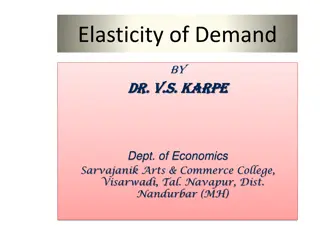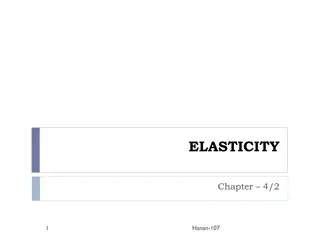Insights on Price Elasticity of Demand and Consumer Behavior
Understanding the concept of price elasticity of demand, this content explores how changes in price affect consumers' buying behavior. It covers the Veblen effect, Giffen goods, Marshall's example on staple foods, and the responsiveness of demand to price fluctuations. The content also explains elastic, unit elastic, and inelastic demand, with real-world examples illustrating these concepts.
Download Presentation

Please find below an Image/Link to download the presentation.
The content on the website is provided AS IS for your information and personal use only. It may not be sold, licensed, or shared on other websites without obtaining consent from the author. Download presentation by click this link. If you encounter any issues during the download, it is possible that the publisher has removed the file from their server.
E N D
Presentation Transcript
ZPR PWr Zintegrowany Program Rozwoju Politechniki Wrocawskiej
film A measure of the responsiveness of one variable (quantity demanded or supplied) to a change in another variable Most popular elasticity: price elasticity of demand, defined as: % _ _ _ change of quantity _ demanded Price elasticity of demand = % _ change of price
usually takes negative values when price grows, quantity demanded decreases when price decreases, quantity demanded increases the exceptions: the Veblen effect Giffen good
The Veblen effect - some types of high-status goods, such as diamonds or luxury cars, are Veblen goods, decreasing their prices decreases people's preference for buying them because they are no longer perceived as exclusive or high status products. A price increase may increase that high status and perception of exclusivity even more preferable. high status and perception of exclusivity, thereby making the good
The classic example given by Marshall is staple foods quality, whose demand is driven by poverty, that makes their purchasers unable to afford superior foodstuffs. As the price of the cheap staple food rises, they can no longer afford to supplement their diet with better foods, and must consume more of the staple food. staple foods of inferior Marshall wrote in the 1895 in book Principles of Economics: As Mr. Giffen has pointed out, a rise in the price of bread makes so large a drain on the resources of the poorer labouring families and raises so much the marginal utility of money to them, that they are forced to curtail their consumption of meat and the more expensive farinaceous foods: and, bread being still the cheapest food which they can get and will take, they consume more, and not less of it.
Demand is said to be: elastic when Ed < -1, unit elastic when Ed = -1, and inelastic when Ed >-1.
Even small change of price results decreasing of demand to zero Source of graphics (for all slides): http://www.oswego.edu/~kane/eco101.htm
Customers buy the same amount of good, regardless of good s price
film a price increase from $1 to $2 represents a 100% increase in price, a price increase from $2 to $3 represents a 50% increase in price, a price increase from $10 to $11 represents a 10% increase in price. Note that, even though the price increases by $1 in each case, the percentage change in price becomes smaller when the starting value is larger.
Q Q = _ _ _ price elasticity of demand P P where: Q - change of quantity demanded Q quantity demanded before price change P change of price P price before change
Suppose that quantity demanded falls from 60 to 40 when the price rises from $3 to $5. The price elasticity of demand equals In this interval, demand is inelastic (since elasticity >- 1).
Total revenue = price times quantity What happens to total revenue if the price rises? Ticket prices Demand Price elasticity of demand -oo -4 -1,5 -1 -0,67 -0,25 0 Total revenue 12,5 10 7,5 6,25 5,0 2,5 0 0 20 40 50 60 80 100 0 200 300 312,5 300 200 0
% _ _ _ change of quantity _ demanded Price elasticity of demand = % _ change of price A reduction in price will lead to: an increase in TR when demand is elastic. a decrease in TR when demand is inelastic. an unchanged level of total revenue when demand is unit elastic.
different customers are charged different prices for the same product, due to differences in price elasticity of demand higher prices for those customers who have the most inelastic demand (e.g. rich customers) lower prices for those customers who have a more elastic demand (e.g. poor customers).
Theatres usually charge three different prices a show. The prices target various age groups, including youth, adults and seniors. The prices fluctuate with the expected income of each age category adult population. Firms selling alcoholic beverages, produce similar products but try to promote one as a prestige brand with a much higher price. Prices for flights are different for average customer and business customer (business class). charge three different prices for The prices fluctuate with the expected income of each age category, with the highest charge going to the
Price elasticity of demand is relatively high when: close substitutes are available, the good is not a necessity, the good or service is a large share of the consumer's budget, a longer time period is considered, the customers are rather poor.
Price elasticity of demand is relatively low when: There are no close substitutes (e.g. electricity, water); Good is necessity; Customers are rather rich; The good or service is a small share of the consumer's budget; A shorter time period is considered (no time to change chabits, to look for substitutes).
The cross-price elasticity of demand between two goods j and k is defined as:
cross-price elasticity is positive if and only if the goods are substitutes cross-price elasticity is negative if and only if the goods are complements.
film A good is a normal good if income elasticity > 0. A good is an inferior good if income elasticity < 0.
A good is a luxury good if income elasticity > 1. A good is a necessity good if income elasticity < 1.
short run fixed (constant) all inputs (factors of production) are variable in the long run supply will be more elastic in the long run than in the short run or contract their capital in the long run (e.g. bring employees from abroad). short run - period of time in which capital is long run supply will be more elastic in the long run than in the short run since firms can expand
rwnanie equation uk ad r wna - simultaneous equations u amek fraction u amek pi trowy compound fraction malej ca (rosn ca) funkcja decreasing (increasing) function funkcja liniowa linear function iloraz quotient iloczyn product r nica difference suma sum sumowanie summation dodatni positive ujemny negative licznik numerator mianownik - denominator
Begg D. Fischer S., Dornbusch R., Economics, 2008 Czarny B. Podstawy Ekonomii , PWE 2010. http://www.oswego.edu/~kane/eco101.htm www.wikipedia.org Wood, John C. (1993). Thorstein Veblen: Critical Assessments, 352. London Alfred Marshall, 1895. Principles of Economics Bk.III,Ch.VI in paragraph III.VI.17 Graphics sources: http://www.oswego.edu/~kane/eco101.htm
Give some examples of goods with inelastic demand? Describe why demand is inelastic for these goods. Give some examples of goods with very elastic demand? Describe why demand is very elastic for these goods. What is price discrimination. Give examples. What is the difference between normal goods, luxury goods and inferior goods? Give examples. Make a proof that at the level of price at which Epd=-1 the TR takes maximum value. Assume linear relationship between P and Q. What is the inluence of price comparison services on price elasticity of demand in e-commerce. Give examples. Explain why the long run price elasticities of supply are larger in magnitude when compared with the short-run price elasticities. Give examples. 1. 2. 3. 4. 5. 6. 7.























